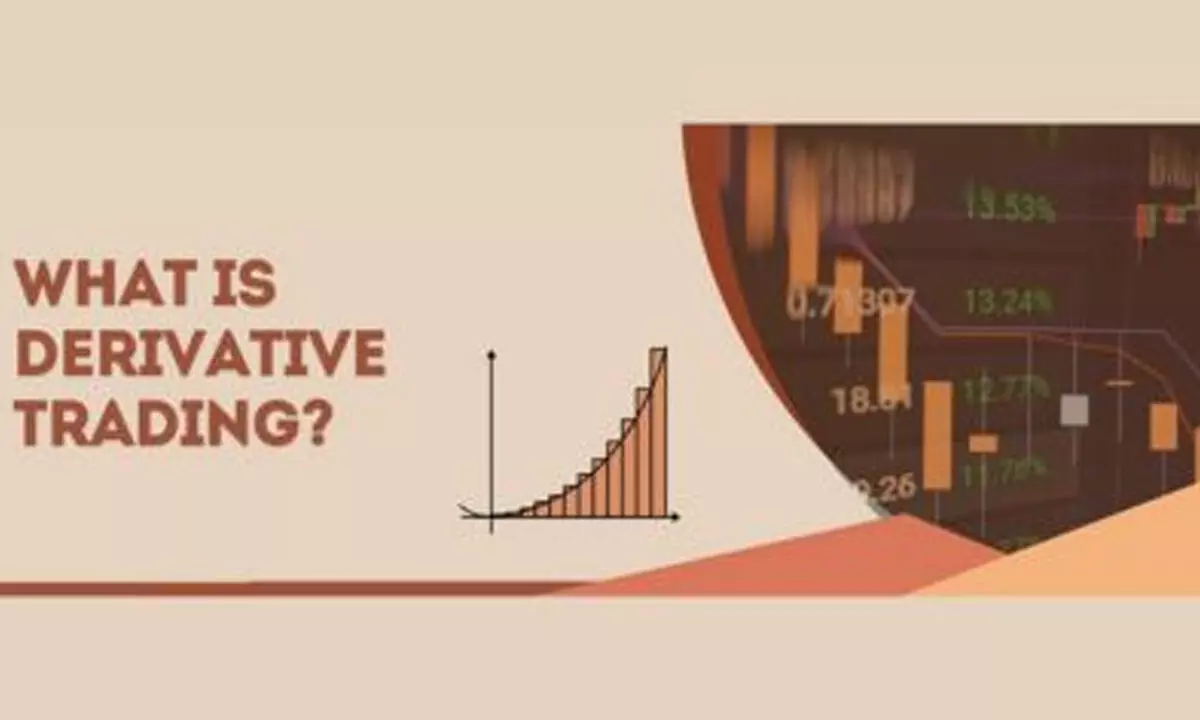Live
- Strict measures in Place for AP SSC examinations
- Kancha Gachibowli land: Activists launch campaign to preserve urban lung space
- GHMC proposes euthanasia for aggressive strays
- Over 6 lakh Olive Ridleys turn up at Gahirmatha
- Two women journos held for ‘defaming’ CM
- 25 lakh ‘Lakhpati Didis’ in next 5 years: Patra
- Villagers come together against illegal mining
- NALCO holds Customers’ Meet
- Notorious criminal injured in encounter
- Food safety officials inspect mangoes at Mozamjahi mkt
What are Derivatives, and How Do You Trade Them?


Derivatives have become a popular investment instrument among investors.
Derivatives have become a popular investment instrument among investors. Understanding derivatives and how to trade them can significantly enhance your investment portfolio. This article provides a detailed guide to help you navigate the world of online derivative trading and Commodity Derivatives.
What are Derivatives?
Derivatives are financial contracts whose value is derived from an underlying asset. These assets include stocks, bonds, commodities, currencies, interest rates, and market indexes. Derivatives are used for various purposes, such as hedging risk, speculation, and arbitrage.
Types of Derivatives
1. Futures Contracts: Agreements to buy or sell an asset at a future date at a price agreed upon today.
2. Options Contracts: These give the buyer the right, but not the obligation, to buy or sell an asset at a predetermined price before or at the expiry date.
3. Swaps: Contracts where two parties exchange cash flows or other financial instruments.
4. Commodity Derivatives: These are based on commodities like gold, silver, oil, and agricultural products.
Steps to Start Online Derivative Trading in India
Step 1: Understand the Basics
This involves knowing what derivatives are, different types of derivatives, and their characteristics.
Step 2: Choose a Broker
Selecting the right broker is crucial for successful online derivative trading. Consider the following factors:
1. Reputation: Choose a broker with a good track record.
2. Fees and Commissions: Look for competitive rates.
3. Trading Platform: Ensure the platform is user-friendly and offers the necessary tools for trading.
Step 3: Open a Trading Account
You need to open a trading account with a registered broker to trade derivatives. Here's how you can do it:
1. Document Submission: Provide documents like PAN card, Aadhaar card, bank statement, and address proof.
2. Account Verification: Complete the KYC (Know Your Customer) process, which most brokers offer online.
3. Fund Your Account: Transfer funds from your bank to your trading account to start trading.
How to Trade Futures and Options?
Futures Trading
Futures contracts involve agreeing to buy or sell an asset at a future date for a predetermined price. Here's how you can trade futures:
1. Choose the Asset: Decide the underlying asset you want to trade.
2. Select the Contract: Look for contracts available for your chosen asset.
3. Place an Order: Use your trading platform to buy or sell orders.
4. Monitor Positions: Keep track of your positions and adjust them as needed.
Options Trading
Options give you the right, but not the obligation, to buy or sell an asset. There are two types of options: call and put options.
1. Call Option: Gives you the right to buy an asset.
2. Put Option: Gives you the right to sell an asset.
Steps to Trade Options:
1. Select the Underlying Asset: Choose the asset on which you want to trade options.
2. Pick the Option type: Decide whether you want to trade a call or put the option.
3. Set Strike Price and Expiry Date: Determine your option's strike price and expiry date.
4. Execute the Trade: Place your order through the trading platform.
Trading Commodity Derivatives
Commodity Derivatives are based on physical commodities like gold, silver, oil, and agricultural products. Here's how you can trade them:
Step 1: Understand the Market
Commodity markets can be volatile. Understanding the factors that influence commodity prices, such as supply and demand, geopolitical events, and economic indicators.
Step 2: Choose the Right Exchange
The primary exchanges for Commodity derivatives in India are the Multi Commodity Exchange (MCX) and the National Commodity & Derivatives Exchange (NCDEX).
Step 3: Select the Commodity
Decide which commodity you want to trade. Each commodity has its characteristics and may be influenced by different factors.
Step 4: Analyse the Market
Use technical and fundamental analysis to make informed trading decisions. Fundamental analysis involves studying the underlying forces affecting the commodity, while technical analysis uses charts and patterns to predict future price movements.
Step 5: Place the Trade
Once you decide, place your buy or sell order through your broker's trading platform. Monitor your trades and manage your risk appropriately.
Risk Management in Derivative Trading
Trading derivatives involves significant risk. Here are some strategies to manage risk:
Set Stop-Loss Orders
Stop-loss orders can help limit potential losses by automatically selling a position when it reaches a specific price.
Diversify Your Portfolio
Avoid putting all your money into a single trade or asset class. Spread your investments across different assets to reduce risk.
Stay Updated
Keep yourself informed about market trends and news that can impact your trades. Review your positions regularly and make necessary adjustments.
Conclusion
Trading derivatives can be a lucrative endeavour if done correctly. You can successfully navigate online derivative trading and Commodity Derivatives by understanding what derivatives are and how they work, choosing the right broker, and employing effective trading and risk management strategies.
(No Hans India Journalist was involved in creation of this content)

© 2025 Hyderabad Media House Limited/The Hans India. All rights reserved. Powered by hocalwire.com






